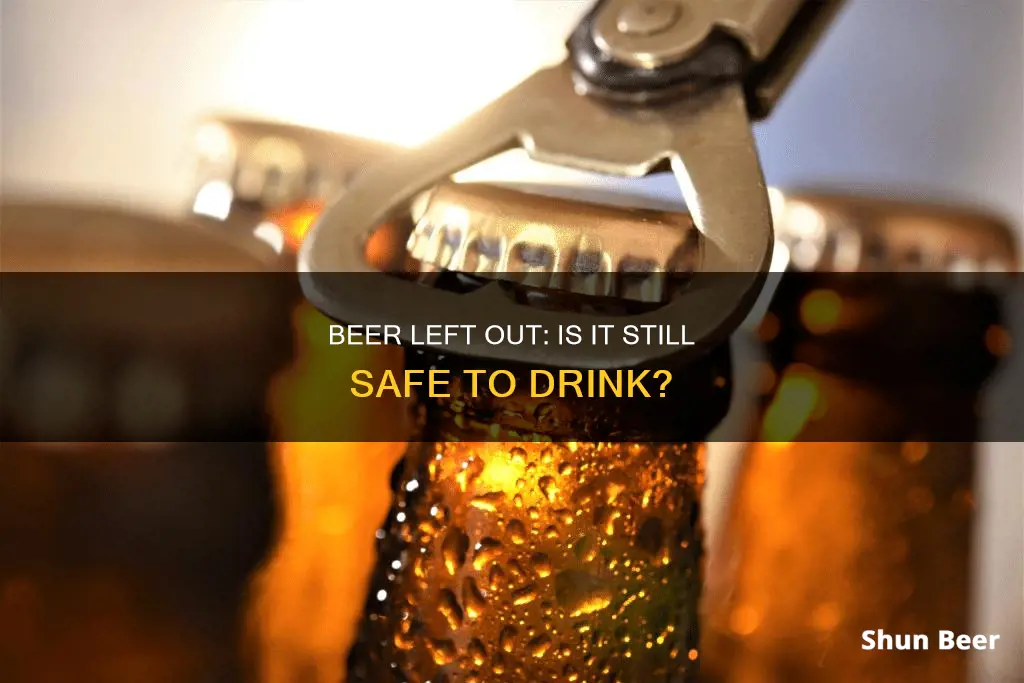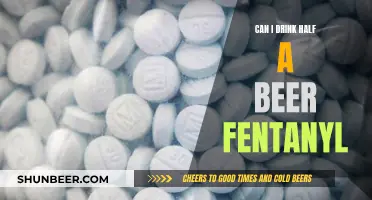
Whether it's okay to drink beer that has been left out depends on several factors, including the type of beer, its alcohol content, and the storage conditions. Generally, unopened beer can last up to six months when stored at room temperature, while opened beer can last up to a few days to a week in the fridge. Beer that has been left out will likely be flat and have a different taste, but it is usually still safe to drink unless it shows signs of spoilage, such as an unpleasant odour, strange taste, or visible mould. To extend the shelf life of beer, it is recommended to store it in a cool, dry, and dark place, such as a refrigerator, and to keep the bottles or cans sealed to prevent oxygen exposure.
What You'll Learn

Is it safe to drink beer that's been sitting out?
Whether it's safe to drink a beer that's been sitting out depends on several factors, including the type of beer, the temperature, and the length of time it has been left out.
Firstly, it's important to distinguish between an unopened and an open beer. An unopened beer that has been sitting out will likely be safe to drink, although its taste may be affected. The fermentation process used in brewing, as well as the low pH level and alcohol content, make it difficult for bacteria to grow in sealed beer. However, if an unopened beer has been left out in the sun or exposed to high temperatures, it may spoil faster due to oxidation, and its taste may be compromised.
On the other hand, an open beer that has been sitting out is more susceptible to bacteria and microbes, and its carbonation will also start to decrease. As a general rule, an open beer can be left out for about 30 minutes to 2 hours before it becomes flat and less palatable due to oxidation. However, this timeframe can vary depending on the type of beer and the temperature. Lighter beers, such as lagers and pilsners, are more vulnerable to higher temperatures, while darker or higher-alcohol beers like stouts and porters have slightly higher heat resistance.
To ensure the safety and quality of your beer, it is recommended to consume an open beer within 24 to 48 hours, especially if it is stored in a cool, dark place. If the beer has been left out for an extended period, it is important to look for signs of spoilage, such as an off-smell, colour changes, or a flat taste. While it may not be harmful to consume a slightly stale beer, it is always better to err on the side of caution and discard it if there are any indications of bacterial growth.
Additionally, proper storage can help extend the life of an open beer. It is recommended to refrigerate the beer immediately and seal it tightly to minimise air exposure.
Cheers to Real Beer: What the Cast Really Drank
You may want to see also

How does temperature affect beer?
Temperature has a significant impact on beer. While cold beer is generally preferred, and cold storage helps beer stay fresh for longer, higher-than-normal temperatures can negatively affect a beer's flavour. Heat speeds up the oxidation process, causing some beers to develop a stale, cardboard-like flavour with a hint of sherry. More malt-forward beers may even take on a sweet, bready, and toffee-like flavour. Additionally, the "hoppiness" of a beer will dissipate with extreme heat, causing the loss of any piney, citrusy, or floral hop aromas.
The effect of heat on beer is exponential; a beer sitting at 60 degrees Fahrenheit will retain its original flavour for much longer than a beer at 90 degrees Fahrenheit. Extreme heat, such as temperatures above 80 degrees Fahrenheit, will ruin beer.
It is also worth noting that major temperature fluctuations, such as from an ice-cold cooler to a hot car, can negatively impact beer. Once beer has been subjected to extreme heat, the damage cannot be reversed.
To maintain the optimal flavour of beer, it is best to store it in a cool, dark place, preferably a refrigerator. If storing at room temperature, ensure the beer is not exposed to direct sunlight. Additionally, keeping beers upright allows for less exposure to oxygen than storing them on their side.
Drinking Beer from Mason Jars: Is It Okay?
You may want to see also

How does light affect beer?
Light, especially UV light, can cause beer to become "skunky" or "light-struck". This is due to a chemical reaction that occurs when light interacts with the hops in beer, which act as a preservative and flavouring agent. The reaction can happen in a matter of minutes in direct sunlight, and within hours in indirect light.
The wavelengths of light that cause this reaction fall between 350 and 550 nanometres. Sunlight is the biggest culprit when it comes to skunking beer, but artificial light can also have this effect. Incandescent and halogen lights are less likely to cause skunkiness than LED and fluorescent lights, which emit wavelengths of light that are particularly conducive to the chemical reaction.
The colour of the beer and the glass bottle also play a role. Dark beers absorb a broader spectrum of light wavelengths than lighter beers, so the lighter the beer, the more likely it is to turn skunky. Similarly, brown glass absorbs the blue, purple and green wavelengths that catalyse the reaction, whereas clear, green and blue glass allow some or all of these wavelengths to pass through.
To avoid skunkiness, beer should be fermented and stored in a dark place, and covered with a cloth or towel if necessary.
Beer and Shraddha: A Spiritual Conundrum for Devotees
You may want to see also

How long can an open beer be left out?
An open beer can be left out for about 30 minutes to 2 hours before it becomes flat and undrinkable. After this time, the beer may taste stale due to oxidation. However, this can vary depending on factors such as temperature and exposure to light.
Lighter beers, such as lagers and pilsners, are particularly vulnerable to higher temperatures, which can accelerate spoilage by promoting faster oxidation and loss of carbonation. These beers are best kept in cooler environments to preserve their crisp and refreshing taste.
Ideally, you should store beer at typical refrigerator conditions—35°F and 46°F. If you don’t have access to a fridge, choose a cool, dark place that is undisturbed by regular movement, such as a pantry or cellar. Beer will likely last longer in these areas as the temperatures are lower.
The sun's rays are notorious for shortening beer's shelf life. They penetrate bottles and trigger a chemical reaction that breaks down its taste components, causing flavour deterioration. This is more prominent in beers like India Pale Ales and other light beers, which are best consumed within three months of packaging.
Oxygen exposure is another significant factor affecting beer's shelf life and quality. When oxygen comes into contact with the beer, it can cause oxidation, degrading the beverage's flavour and changing its colour. Bottled beer is more susceptible to oxygen exposure than canned beer. To minimise this risk, store the beer upright to reduce the surface area in contact with oxygen.
Generally, an open beer will only be fresh for 1-2 days, so it should be consumed within this period to enjoy its best flavour. It can be consumed after three days, but the taste will be far from pleasant.
Can Women Drink Beer and Drive Safely?
You may want to see also

What are the signs of spoilage?
The signs of spoilage in beer are similar across different beer styles. However, the intensity and nature of these signs can vary, with lighter beers showing more noticeable changes sooner. Here are some of the key signs to look out for:
- Visual cues: A noticeable haze or sediment formation that is not typical for the specific beer style can indicate spoilage. For example, beers meant to be clear should not become cloudy without a reason.
- Olfactory cues: A sour or acidic smell, similar to vinegar, can signal bacterial contamination, which may pose potential health risks if consumed.
- Taste changes: A marked shift in taste, such as an unwelcome sourness, excessive bitterness, or a flat, lifeless profile, suggests the beer has gone beyond its prime.
- Off-smells: An off-smell or a musty smell can indicate spoilage.
- Colour changes: Changes in the colour of the beer, such as cloudiness or unusual appearance, can be a sign of spoilage.
- Flat taste: A flat or bland taste can occur due to carbonation loss, which affects the texture and taste of the beer.
- Loss of fizz: If your beer has lost all its fizz, it's a sign that the seal was broken, and the flavour will be significantly different.
- Vinegary taste: If a beer that is not supposed to be tangy or acidic develops a vinegary taste, it indicates bacterial contamination and should be discarded.
- Excessive sediment: Checking the bottom of the bottle for excessive sediment can help identify potential spoilage, as this could contribute to a poor taste.
It is important to rely on your senses to judge the condition of an open beer. When in doubt, it is better to discard the beer. Proper storage, such as refrigeration and airtight sealing, can help extend the shelf life of an open beer.
Beer and Rum: Mixing Alcohol Safely
You may want to see also
Frequently asked questions
Drinking beer that has been left out in the sun for a prolonged period is not recommended, as it can result in a flat beer with a compromised flavour. However, it is unlikely to pose any serious health risks.
An open beer typically remains drinkable for up to two days. However, it is best consumed within 24-48 hours to enjoy its optimal taste and quality.
Leaving beer out overnight will not expose you to health risks, but it may lose its carbonation and its flavour may deteriorate.
Spoilt beer often exhibits strange smells, such as a skunk-like or urine-like odour. It may also have an unusual taste, such as metallic, sour, or cardboard-like flavours, and a cloudy appearance.
To extend the shelf life of beer, it is recommended to store it in a cool, dry, and dark place, such as a refrigerator, maintaining temperatures between 35 and 55 degrees Fahrenheit (2 to 13 degrees Celsius). Additionally, ensure that the beer remains sealed and is stored upright to minimise oxygen exposure.







